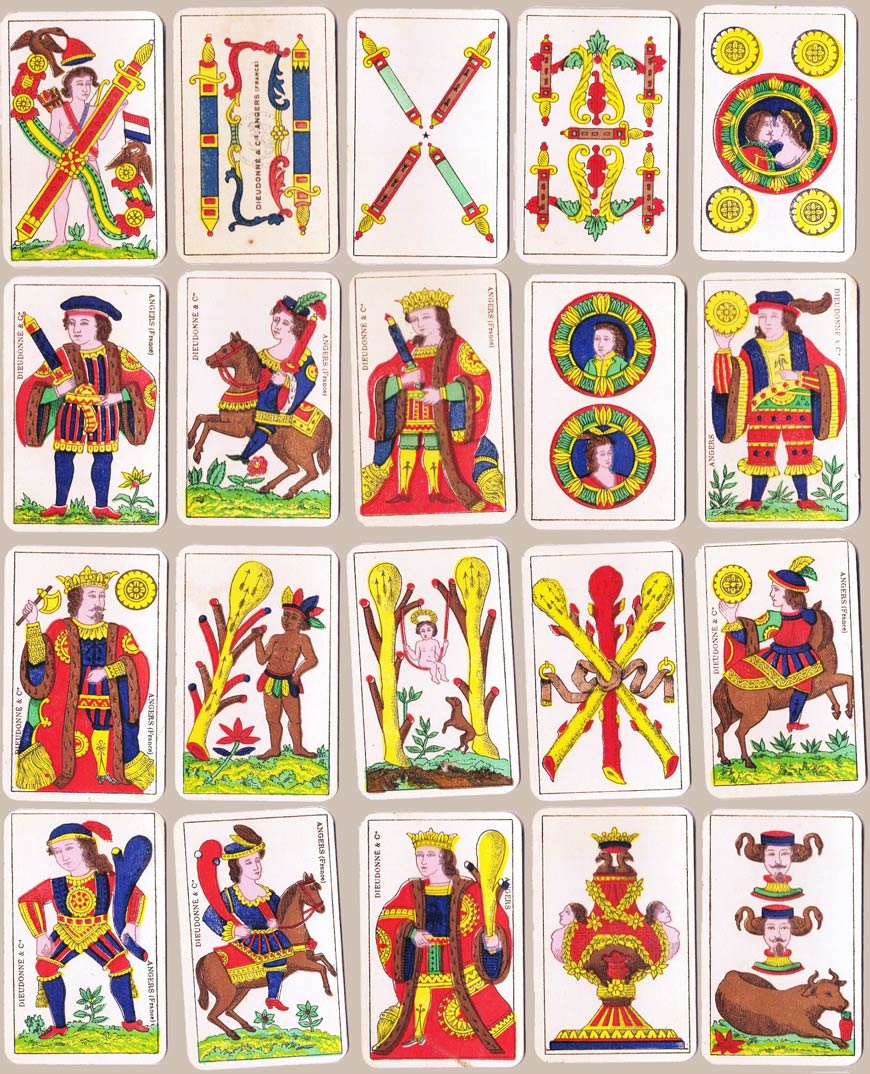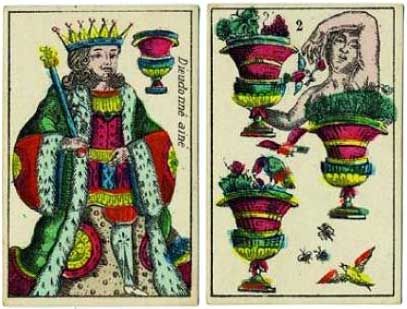Dieudonné & Cie Aluette
Aluette playing cards manufactured by Dieudonné & Cie, Angers (France), early 20th century.
Aluette playing cards
manufactured by Dieudonné & Cie, Angers (France), early 20th century.
Aluette is a card game popular in Brittany and the West coast of France, usually played with a special pack the design of which is descended from Archaic Franco-Spanish models which were also used in France. The cards have Spanish suit symbols, the courts have become somewhat stylised and many of the numeral cards contain additional decorative motifs or embellishments which were incorporated by earlier manufacturers or are related to the game-play. Traditional (or archaic) features include a kissing couple on the Five of Coins (once the Catholic monarchs Ferdinand and Isabella) and a naked child on the Ace of Swords. The Cavalier of Coins is shown in partial back-view. See also → Lequart Aluette Dieudonne Catalanes France-Cartes Aluette 1976

Above: Aluette playing cards by Dieudonné & Cie, Angers (France).
Some History
In around 1754 Jean Dieudonné (c.1720-1795) relocated from Metz in France to Grevenmacher, in eastern Luxembourg, near the border with Germany. In that same year, being a widower, he re-married Marie Elisabeth Lejeune, a merchant’s daughter. After launching his new business and building it up, he successfully become head of a dynasty of cardmakers. After Jean Dieudonné's death the business was managed by his widow, Marie Elisabeth Lejeune.

Above: 2 cards by Mathias Dieudonné the elder, before 1840.
The history of the firm is closely linked to the political changes that have marked its existence. Thus, following the French Revolution and the annexation of Luxembourg in 1795, it was forbidden to represent crowned heads on playing cards, and when in 1797 the French government introduced the tax on card games, it took all the commercial intelligence of the Dieudonnés to ensure the survival of the company. Several sons and grandsons became cardmakers thereby continuing the family name (Georges (1759-1828), Jean II (1764-1793), Mathias I (1768-1840), Mathias II (1795-after c.1840) and Antoine Dieudonné (1789/1802-1864)).
Cremers (1994, p.63) suggests that Jean Dieudonné may have learned his trade at Metz but been forced into exile by the strict tax regulations in France. His move to Gravenmacher may have been in order to avail himself of paper supplies, materials and clients in the Rhine valley area, accessible via the Moselle river. The products of the Dieudonné factory were mainly intended for the foreign market, the tax advantages in Luxembourg creating a context favourable for this flourishing craft. Seeking government tax concessions, Dieudonné claimed to be the sole supplier of playing cards to the inhabitants of Luxembourg. The successors of Jean Dieudonné continued the manufacture in Grevenmacher until 1880, when Jean-Paul Dieudonné decided to abandon the production of cards in the township. Other branches of family descendents emigrated to France, Orleans and Angers, taking the business with them where it became known as Dieudonné et Cie.

Above: uncoloured and stencil-coloured uncut sheets of the Hamburg pattern by Dieudonné (France), c.1850. In the coloured version, successive stencil colourings of pale blue, blue, yellow, red and black have been applied. The Hamburg pattern is based on the Paris pattern and was used in Germany and Scandinavia.
REFERENCES
Cremers, Filip: Kaartenmakers in Wallonië - Cartiers en Wallonie, Nationaal Museum van de Speelkaart, Turnhout, 1994
Kulturhuef Museum, Grevenmacher: the playing cards of Jean Dieudonné►

By Simon Wintle
Member since February 01, 1996
I am the founder of The World of Playing Cards (est. 1996), a website dedicated to the history, artistry and cultural significance of playing cards and tarot. Over the years I have researched various areas of the subject, acquired and traded collections and contributed as a committee member of the IPCS and graphics editor of The Playing-Card journal. Having lived in Chile, England, Wales, and now Spain, these experiences have shaped my work and passion for playing cards. Amongst my achievements is producing a limited-edition replica of a 17th-century English pack using woodblocks and stencils—a labour of love. Today, the World of Playing Cards is a global collaborative project, with my son Adam serving as the technical driving force behind its development. His innovative efforts have helped shape the site into the thriving hub it is today. You are warmly invited to become a contributor and share your enthusiasm.
Related Articles

Archaic Spanish-suited pattern from Bayonne
Archaic Franco-Spanish pattern from Bayonne by a manufacturer with the initals M.V.

Caisse Mutuelle d'Assurance et de Prevoyance
Insurance propaganda pack for Caisse Mutuelle d'Assurance et de Prevoyance with humorous artwork by ...

Jeu Révolutionnaire
Court cards and aces from a French Revolutionary pack by Pinaut, Paris, c.1794.

French Revolutionary cards by Pinaut
Seven cards from a French Revolutionary pack by Pinaut featuring characters from classical antiquity...

Never Mind the Belote
Limited edition Belote pack with designs by a collective of 24 street artists.

Sannois dans les étoiles
Celebrities and buildings associated with Sannois, a commune in the suburbs of Paris.

Le Globe Céleste
Views and plans of five international exhibitions held in Paris between 1855 and 1900.

Le Journal de Mickey
Perforated sheet of cards with Disney characters issued with the magazine Le Journal de Mickey.

Tarot hiéroglyphique égyptien
The design of the cards draws inspiration from various religious and philosophical traditions merged...

La Réussite (Sébastien Féraut)
Sébastien Féraut’s designs inspired by the animal kingdom for a set promoting patience games.

Le Tarot de Sète
Reinterpretation of the Tarot de Marseille by Julien Labat, an artist from Sète.

Oracle Rock
Cartomantic set depicting rock and pop stars, designed by La Rata, with a book by Virginie Despentes...

Jeu Numismatique
European coins of all periods replace the traditional courts and pips.

Jeu Philatélique
Cards with French postage stamps featuring famous literary figures.

Tarot Philatélique
Tarot game pack with French postage stamps on all the courts, aces and trumps.

Jeu Philatélique – Les Colonies Françaises
Philatelic card game featuring real postage stamps from the French colonies.
Most Popular
Our top articles from the past 28 days


